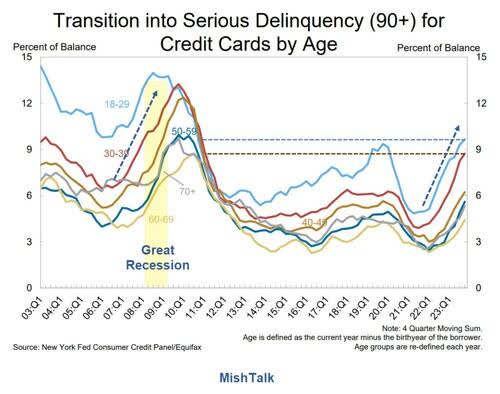
The Russian credit card market faces a potential debt crisis.
Russian credit card holders are finding it increasingly difficult to manage their debts. Data from early June reveals that 8.3 million individuals had payments overdue by over three months, according to the «Scoring Bureau». Concurrently, the total number of new credit cards issued in Russia in May dropped below 1 million, the lowest level seen in four years (since Q1 2021). Experts shared their insights on the implications of these figures and the potential consequences of the escalating credit card debt.
Banks issued only 986,000 credit cards in May, a 2.3% decrease year-on-year and a 3.7% decrease month-on-month. The «Scoring Bureau» highlighted that this is the lowest monthly issuance volume since the first quarter of 2021.
Credit card debts have surged alongside the slowdown in new card issuance. By May 31, the number of Russians with payments overdue by over 90 days reached 8.3 million. This figure stood at just over 7.7 million on January 1 and 6.9 million a year prior. Total outstanding debt also climbed, reaching 575.9 billion rubles by the end of May, up from 508.3 billion at the start of the year and 426.7 billion a year earlier. Furthermore, short-term delinquencies (30 and 60 days overdue) are also rising. In May 2025, the overall percentage of credit cards with any level of delinquency represented 12% of the total cards issued, with overdue amounts constituting 11.3% of banks` credit card portfolios.
Analysts attribute the sharp increase in delinquencies to trends from previous years. Yulia Kuznetsova, President of the Association of Investment Advisers on the Stock Market, states:
«The cause is the aftermath of the credit boom in 2023–2024, when banks extensively issued unsecured loans, including credit cards, without adequately evaluating borrowers` ability to repay.»
She adds that for many, facing stagnant incomes and high inflation, credit cards became less of a liquidity tool and more the sole means to cover daily expenses, leading to a widespread rise in defaults. Kuznetsova emphasizes that over 90-day delinquencies on millions of cards signify that borrowers have not simply missed payments but have fundamentally lost the capacity to service their debt. The simultaneous rise in short-term delinquencies (30 and 60 days) further suggests a growing debt crisis, according to the expert.
Analysts predict the surge in overdue debt has not yet peaked. Heavily indebted individuals will continue trying to borrow, but stricter regulations from the Central Bank of the Russian Federation have already limited many options. The total number of defaulters could reach a historic high by the end of the first half of the year.
«While this isn`t currently a systemic banking crisis, the risk of it escalating into a stress scenario is significant,» warns Kuznetsova. «Banks with a large share of unsecured portfolios are especially susceptible. Given the high key interest rate (20%) and restricted refinancing options, the increase in delinquencies is viewed not as a temporary issue but as a result of a fundamental structural imbalance.»
Banking data suggests a substantial part of the population experiences chronic financial shortfalls, using debt to supplement inadequate income. This situation could lead to tougher requirements for new loans for Russians, damaged credit scores, and reduced financial maneuverability. The investment adviser also cautioned about a potential decline in consumer spending and an increase in social and debt-related stress.
According to Meri Valishvili, Associate Professor at Plekhanov Russian University of Economics, the current situation carries long-term negative implications, as «economic development reserves are largely depleted,» a point also made by Central Bank head Elvira Nabiullina. This suggests little prospect for income increases or lower rates on other credit products. However, Valishvili believes it`s too early to declare a banking system crisis. She explains that with a high key rate, banks aim to maximize interest earnings and impose higher risk premiums on clients with existing debt.
Svetlana Zubkova, Associate Professor at the Financial University, points out that delinquency isn`t limited to credit cards but is also rising across other types of retail loans. According to the Bank of Russia, total overdue debt on individual loans reached 1.455 trillion rubles by May 1, 2025, a 14% jump from the start of the year. Despite this, Zubkova notes that the overall share of overdue debt remains manageable, around 4%, and banks are actively managing the situation.
Natalia Milchakova, Lead Analyst at Freedom Finance Global, highlights that credit card debt terms are considerably more flexible than those for personal loans. Once the grace period ends, a borrower only pays interest on purchases made; simply paying the minimum amount on time prevents the account from being marked as delinquent, even if the full balance is carried for years. She considers credit cards closer to microloans than personal loans, which typically have much larger average limits (300,000-500,000 rubles).
Milchakova concludes:
«Consequently, we do not believe that the rise in credit card delinquencies poses a threat of a banking system crisis, much less to the national economy overall, given that the impact of defaults on these smaller loans on overall financial stability is minimal.»
She adds that delinquencies may keep rising while interest rates are high, but ultimately, improving the credit card payment situation hinges on stable household incomes and consistent wage growth.











